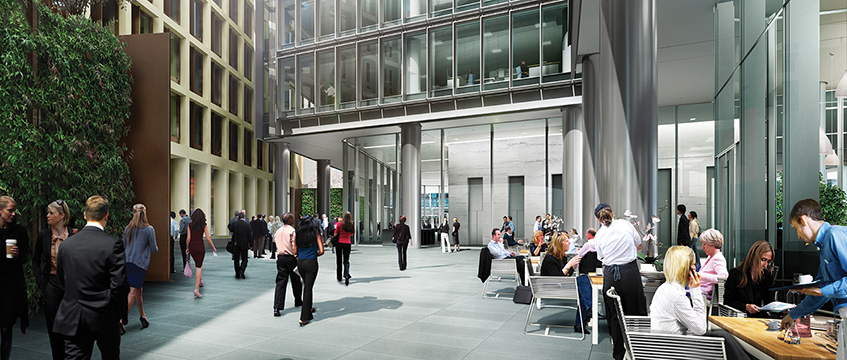A raft of law firms including Charles Russell and Fried Frank are exploring office moves within central London as their management teams rethink their real estate strategies.
Analysts at JLL say active requirements for the sector stood at more than 850,000 sq ft as of the end of June. That figure compares to 750,000 sq ft of take-up in London last year, itself a three-year high.
Charles Russell’s hunt for up to 150,000 sq ft is the most notable search under way, according to JLL’s report, with Watson Farley & Williams and Baker McKenzie also among the firms looking for the largest new homes.
At the same time, many firms are shifting the geographical balance in their property portfolios, with a new focus on expansion outside of the capital. “While London will continue to be most law firms’ primary base, firms will grow their headcounts in the capital more selectively,” JLL’s analysts say.
The costs of people and property
JLL suggests that several factors are encouraging law firms to change the way they operate, including the growth of clients’ in-house legal teams, which is in turn causing the legal sector to consider its workplace needs.
“It is essential that law firms continue to emphasise the importance of their real estate strategy and further evaluate their existing portfolios to assess the opportunity to leverage work from different locations,” says Owen King, director of corporate research at JLL.
Law firms face increasing competition from several sources. So-called alternative legal service providers such as Epiq and Consilio can provide services including document reviews and record management more cheaply. Major accountancy firms, meanwhile, have been upping the legal services they provide. Last summer, for example, EY acquired alternative provider Riverview Law to bolster its position as “a leading disruptor of legal services”.
In addition, American law firms expanding in the UK are piling on the pressure, luring the brightest stars from top “magic circle” firms with lucrative pay packages, JLL says.
This is all pushing salaries up and limiting fees, the agency adds.
The result is that despite law firms’ revenues growing by 6% to just over £35.5bn last year, according to the Office for National Statistics, many are looking to cut costs, including through a drive to manage their workspace needs more efficiently.
The main costs for law firms are people and property, equivalent to 40% and 8% of the fee income of the UK’s top 100 firms respectively, according to PwC’s 2018 Annual Law Firms survey. The two are closely intertwined. The war for talent means law firms are looking more closely at what they offer their staff, including the working environment they provide.
The type of talent law firms need to attract is also shifting as technology continues to change the nature of the way law firms do business.
For example, Clifford Chance has been creating new project management, data science and coding roles as part of a reorganisation of its IT team.
Others are considering trimming the number of juniors they take on, having already looked to cut support and back office staff, as work traditionally carried out at this level becomes increasingly automated, JLL says in its report. Kira Systems, which produces artificial intelligence software for law firms, claims its customers have made time savings of up to 90% on tasks such as due diligence contract reviews.
Some firms are investing in and developing their own systems in response. Slaughter and May has invested in AI platform Luminance, while Allen & Overy has created its own incubator space for legal tech firms.
Moves beyond the capital
Migrating jobs out to the regions and limiting headcounts in London is another step being taken by law firms scrutinising their costs and efficiency. Since 2012 employment by the legal sector has fallen by around 3,000 people in London, while growing in almost every other region of the UK, JLL reports.
Salaries outside of London in the legal sector are generally less and rents in regional cities can be less than half of those in the capital.
Correspondingly, since 2014 law firms have leased more than 1.5m sq ft of space across Belfast, Birmingham, Bristol, Edinburgh, Glasgow, Leeds and Manchester.
Freshfields doubled its footprint in Manchester last year, for example, while reducing its space in London by 120,000 sq ft with its planned move to 100 Bishopsgate (pictured).
Law firms have also undertaken several initiatives to make the space they occupy more efficient, including reducing the amount of storage needed. That allows them to take less space when relocating or to take advantage of the opportunity to sublease or dispose of excess space.
Workplace strategy has become a priority for property professionals in law firms as they look to break away from the spacious cellular layouts still prevalent in law firm offices, but which have disappeared in other sectors.
According to JLL, law firms allocate an average of 215 sq ft for each employee compared with an average of 125 sq ft by insurance firms and 105 sq ft by investment banks.
Beyond creating more open-plan offices, some law firms have also begun to adapt to more agile ways of working, which can eliminate up to 30% of their office space requirements by providing fewer desks or offices than there are employees, based on the knowledge that it will be rare for more than 70% of employees will be in the office on the same day, JLL says.
JLL points to an unnamed top law firm that has implemented hot-desking but has also installed sensors to track when people are at their desk and for how long. That gives the firm data to use when planning new office layouts or leases, the agency says.
To send feedback, e-mail louise.dransfield@egi.co.uk or tweet @DransfieldL or @estatesgazette











